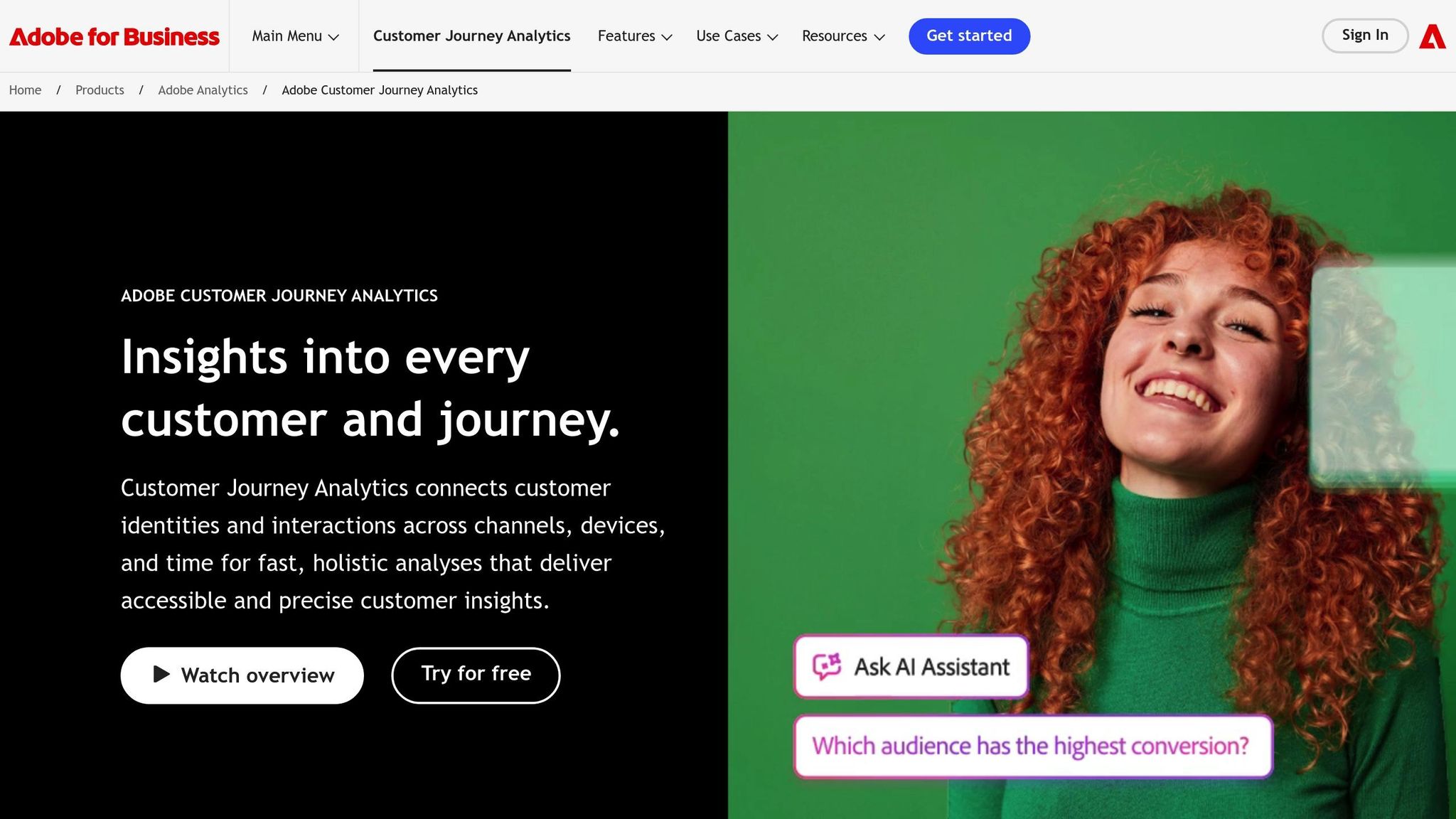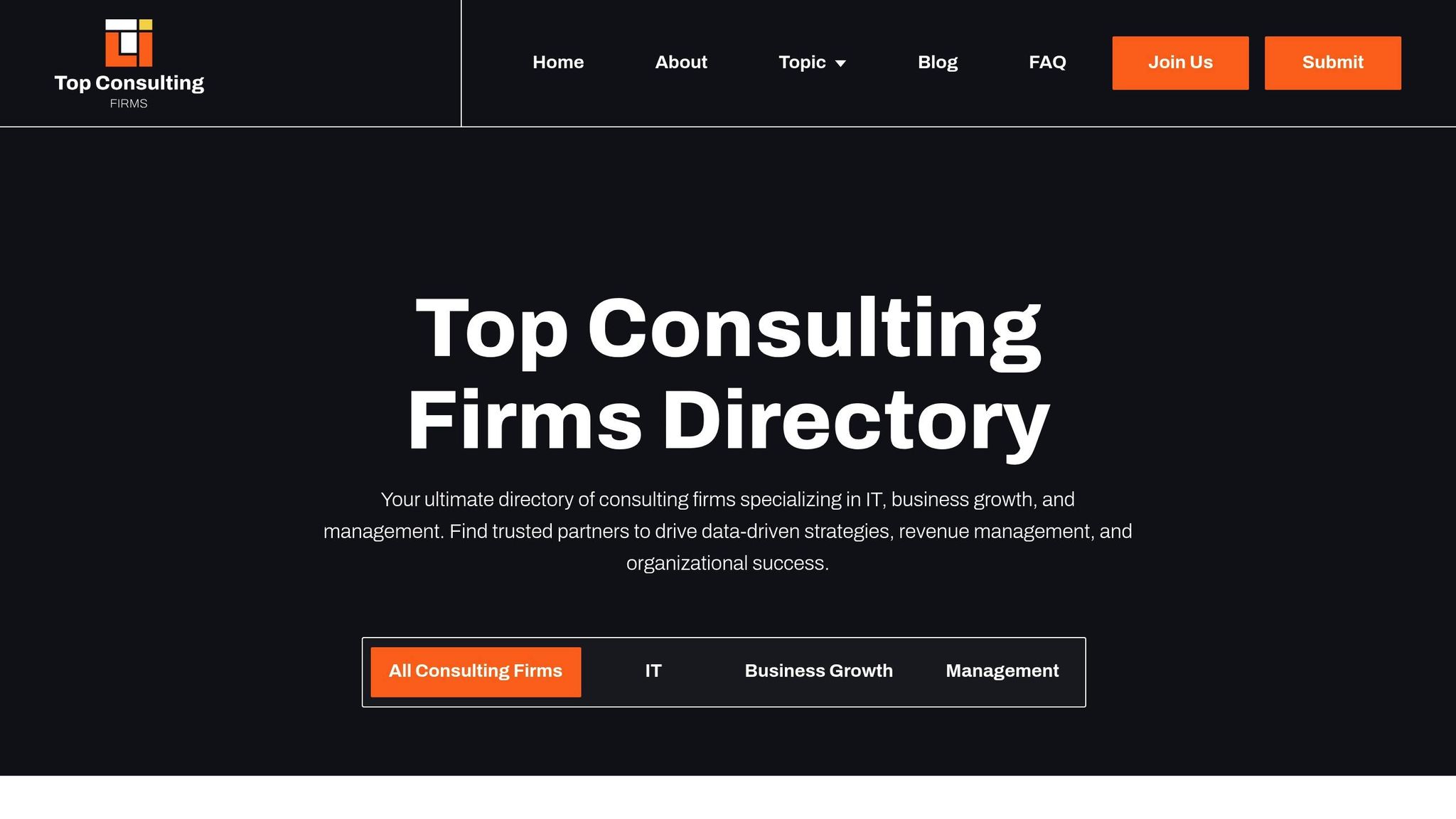Understanding cross-channel customer behavior is critical to improving marketing strategies and customer experiences.
Customers interact with brands through numerous channels - websites, social media, emails, stores, apps, and more. Tracking these touchpoints can feel overwhelming, but visualizing this behavior helps businesses identify trends, resolve pain points, and improve decision-making.
Here’s how to get started:
- Map touchpoints: Identify all the ways customers interact with your brand, including digital and physical channels.
- Unify data: Link customer interactions using identifiers like emails, phone numbers, or customer IDs.
- Clean and standardize data: Remove duplicates, fix errors, and format data consistently.
- Choose visualization tools: Use methods like Sankey diagrams, heatmaps, or journey maps to clarify insights.
- Act on insights: Spot trends, address bottlenecks, and refine strategies based on the visualized data.
Creating Cross-Channel Visualizations in CJA

Preparing and Integrating Cross-Channel Data
To create meaningful visualizations, you need clean, unified data from all customer touchpoints. This step is the foundation for generating accurate insights and ensures your data tells the right story. It’s the bridge between raw data collection and actionable visualization.
Finding Customer Touchpoints
Start by identifying all the ways customers interact with your brand. This includes the obvious ones like your website and social media platforms, but don’t overlook less apparent channels. Think about customer service calls, chatbot conversations, email engagements, SMS responses, and even offline events.
To get a full picture, put yourself in the customer’s shoes. Walk through their journey from the first moment they encounter your brand to purchase and post-purchase interactions. Each channel you uncover adds another layer to the customer profile.
Don’t forget physical touchpoints, especially if your business has retail locations. Point-of-sale (POS) systems, in-store browsing habits, and face-to-face interactions with sales staff provide valuable data. Make sure your POS system collects customer information that can be tied back to their online activity.
Also, include third-party platforms where customers engage with or discuss your brand. Sites like Yelp, Google Reviews, or affiliate websites, along with social media mentions, can offer behavioral insights that enhance your understanding of the customer journey.
Connecting Data with Common Identifiers
Once you’ve mapped out all touchpoints, the next step is linking customer interactions across these channels. Start with email addresses as a primary identifier, and have backup methods ready for anonymous interactions.
For logged-in users, customer IDs work well, but they often miss the anonymous browsing sessions that dominate early-stage interactions. Use phone numbers to bridge the gap between online and offline channels.
Device fingerprinting and cookies can help track anonymous sessions, but privacy regulations limit their use. Instead, focus on encouraging customers to identify themselves voluntarily. For example, offer downloadable resources, exclusive discounts, or personalized recommendations in exchange for an email address or account creation.
For B2B companies, email domains can reveal organizational buying patterns. A single customer might use multiple email addresses from the same company, and connecting these interactions provides insights into complex purchasing behaviors.
Once touchpoints are linked, standardize the data to ensure consistency across your dataset.
Data Cleaning and Standardization
After mapping and linking touchpoints, standardization ensures your dataset accurately reflects customer behavior. Data from various systems often needs alignment to avoid errors like duplicate records or missed connections.
Start with email addresses by converting them to lowercase and removing extra spaces. Create rules for handling variations, like recognizing that gmail.com and googlemail.com are the same provider. For phone numbers, use a consistent format, including country codes if your business operates internationally.
Standardize dates and times to ensure accurate analysis of customer journeys. Different systems may use varying time zones or date formats. Convert everything to a single time zone (UTC is a common choice) and ensure consistent formatting throughout.
For businesses with physical locations, pay special attention to address data. Standardize abbreviations (e.g., Street vs. St., Avenue vs. Ave.), correct common spelling errors, and geocode addresses for location-based insights. This is especially important when connecting online behavior to in-store visits.
Before diving into visualizations, remove invalid data like improperly formatted emails, incorrect phone numbers, or invalid dates. These issues often point to problems in data collection that need to be addressed at the source.
Set up validation rules to catch anomalies. For instance, multiple accounts with the same phone number might indicate errors or shared devices. Similarly, unusually high activity levels could signal bot traffic or system glitches rather than genuine customer behavior.
Duplicate detection is another critical step. Customers may create multiple accounts with small variations in their information. Use fuzzy matching techniques to identify potential duplicates based on similar names, addresses, or contact details, but always manually review matches before merging records.
Finally, establish data retention policies to balance analytical needs with privacy requirements. Older data may lose relevance for decision-making and could pose compliance risks. Define clear timeframes for retaining different types of data, and automate cleanup processes to maintain a streamlined dataset.
Selecting Visualization Methods and Tools
With your data cleaned and organized, the next step is to turn it into meaningful insights. One powerful way to do this is through customer journey mapping, which visually illustrates how customers interact with your brand across various touchpoints - like websites, social media, email, or physical stores - at different stages of their journey (awareness, consideration, purchase, and retention).
This method goes beyond simply tracking customer actions; it uncovers the emotional and psychological factors driving their decisions. Over time, customer journey mapping has shifted from focusing solely on transactions to exploring customer motivations and levels of satisfaction. By mapping out the entire journey, businesses can identify key opportunities to improve experiences and build stronger customer loyalty.
sbb-itb-97f6a47
Step-by-Step Guide to Visualizing Cross-Channel Behavior
This guide walks you through how to turn unified data and visualization techniques into actionable insights that drive better decision-making.
Mapping Customer Touchpoints and Personas
Start by documenting every customer interaction across both digital channels (like websites, social media, email, and mobile apps) and offline channels (such as phone calls, in-store visits, and review sites). This comprehensive mapping ensures no touchpoint is overlooked.
Go beyond surface-level demographics to uncover deeper behavioral patterns, preferences, and challenges. Layer the emotional journey onto the functional path to identify specific triggers that drive engagement and pinpoint friction points that cause drop-offs.
Next, create journey maps tailored to each persona. These maps should highlight the most common paths customers take across your channels, while also noting alternative routes and areas where drop-offs frequently occur. This exercise not only lays the groundwork for your visualizations but also ensures you're tracking the metrics that matter most.
Once you have clear personas and journey maps, you’re ready to build targeted visualizations.
Building Visualizations Using Selected Methods
Choose the visualization method that aligns with your goals. Here are some effective options:
- Sankey diagrams: Ideal for showing how customers move between channels.
- Heatmaps: Great for highlighting intensity patterns across touchpoints.
- Customer journey maps: Provide a detailed, holistic view but may take more time to create and interpret.
To keep your visualizations relevant, integrate your data sources and automate updates. Many analytics platforms offer the ability to create custom dashboards that combine various visualization types, giving you a comprehensive view on a single screen.
Consider organizing your dashboards into layers:
- A master dashboard for an overarching view of performance.
- Focused dashboards that break down data by specific segments, time periods, or campaign types.
Consistency is key. Use the same color coding and labels across all visualizations to avoid confusion. Add clear legends and ensure text is easy to read, especially during presentations.
Before rolling out your visualizations, test them with actual users. What seems straightforward to you might be unclear to others. Collect feedback and refine your visuals to maximize their clarity and usefulness.
Reading Results and Finding Opportunities
Use your visualizations to spot unexpected trends and opportunities. For example, if you notice customers often jump from social media directly to purchases without visiting your website, you may be missing chances to present complementary products or collect more customer data.
Look for patterns, bottlenecks, and timing issues that could signal areas for improvement. For instance, high drop-off rates between touchpoints might indicate problems like mismatched messaging between email and landing pages or a cumbersome mobile checkout process.
Compare the behaviors of your highest-value customers with those of average ones. High-value customers may take different paths or prefer specific touchpoints, offering you insights that can help refine your overall strategy.
Finally, track how changes in one channel affect others. For example, if you adjust your email frequency, monitor whether it impacts website traffic, social media engagement, or even call center inquiries. These subtle cross-channel effects can have a big impact on your overall performance.
Turn insights into action by defining clear steps, like simplifying the checkout process or reducing delays in follow-ups after cart abandonment. These targeted improvements can make a noticeable difference in customer engagement and satisfaction.
Using Consulting Expertise for Cross-Channel Analytics
After organizing and visualizing your data, tapping into consulting expertise can help transform raw insights into actionable strategies. Cross-channel analytics, with its mix of varied data sources and intricate customer journeys, often requires a level of expertise that many businesses find challenging to develop in-house. Bringing in external consultants can speed up progress and lead to better outcomes.
How Consulting Firms Support Cross-Channel Analysis
Consulting firms bring a wealth of specialized knowledge that goes beyond the capabilities of most internal teams. Their experience across industries provides a unique perspective on what works - and what doesn’t - when analyzing customer behavior across multiple channels.
One of their key strengths is integrating diverse systems like CRM platforms, marketing automation tools, e-commerce solutions, and POS systems. Consultants know the best APIs and methods to unify these systems, creating accurate and high-quality customer profiles. They also help businesses make smarter tool choices, recommending solutions that align with your existing data architecture, team skills, and overall goals - helping you avoid expensive missteps.
Beyond system integration, consultants offer expertise in advanced analytics techniques like predictive modeling, attribution analysis, and statistical methods. This allows businesses to go deeper than basic funnel analysis, uncovering complex customer journeys and pinpointing the touchpoints that truly drive conversions.
Consultants also play a crucial role in change management, ensuring new analytics capabilities are adopted successfully. They can design training programs, produce detailed documentation, and establish governance processes to maintain the long-term value of your analytics investments.
Another advantage of working with consultants is their ability to provide an unbiased, strategic perspective. Internal teams, often focused on daily operations, may overlook key opportunities or blind spots. This external viewpoint can lead to fresh insights into customer behavior and uncover new growth opportunities.
Using the Top Consulting Firms Directory

To leverage this expertise, the Top Consulting Firms Directory is a powerful tool that helps businesses find the right consulting partners for their cross-channel analytics needs. Choosing the right partner involves evaluating their expertise, experience, and compatibility with your organization, and this directory simplifies that process.
The directory highlights firms specializing in digital transformation, data analytics, and strategic management - critical areas for effective cross-channel analysis. Instead of spending weeks researching potential partners, you can quickly identify firms with proven experience in areas like cloud services, IT infrastructure, and data analytics.
What sets this resource apart is its focus on firms that prioritize business growth and revenue optimization. Cross-channel analytics isn’t just about tracking customer behavior - it’s about translating those insights into tangible business results. The listed firms have demonstrated success in areas like customer acquisition, product development, and market expansion.
Additionally, the directory includes firms skilled in organizational change and operations management, which are essential for implementing analytics processes across departments. These capabilities ensure that insights lead to actionable decisions and measurable improvements.
When searching for a consulting partner, consider firms that also offer complementary services such as cybersecurity and risk management. Since cross-channel analytics often involves handling sensitive customer data, it’s critical to work with partners who understand both the technical and compliance aspects of data security.
Many of the firms in the directory also provide financial advisory services, which can be invaluable when evaluating ROI across different channels. Sophisticated financial modeling helps businesses optimize marketing budgets and allocate resources effectively, ensuring every dollar spent contributes to measurable growth.
Conclusion
Visualizing cross-channel customer behavior is a powerful way to gain deeper insights and respond effectively to customer needs. By turning fragmented data into clear, actionable insights through unified data preparation, thoughtful visualization, and expert guidance, businesses can unlock new opportunities.
At the heart of effective cross-channel visualization is unified data integration. Connecting interactions across email, social media, websites, and even in-store visits is essential. Without this foundation, businesses risk missing valuable opportunities and wasting resources.
Strategic visualization methods act as the bridge between raw data and meaningful business decisions. Whether it’s journey maps, funnel analyses, or cohort studies, choosing the right visualization tools helps uncover trends and answer critical business questions hidden within the data.
Given the complexity of modern customer journeys, having expert support is invaluable. As discussed earlier, specialists bring proven techniques, advanced analytics, and unbiased insights to the table. Their expertise ensures that visualization efforts go beyond creating attractive dashboards - they deliver measurable business results.
Success in cross-channel visualization isn’t a one-time effort. Customer behaviors constantly evolve, new channels emerge, and business priorities shift. The best strategies treat visualization as an ongoing process, adapting to these changes while staying focused on actionable insights that drive revenue and improve customer satisfaction. Together, these elements transform customer data into a strategic advantage.
Key Takeaways
From integrating data to leveraging expert support, here are the key elements for mastering cross-channel visualization:
- Comprehensive data integration: Clean, standardize, and connect data from all customer touchpoints to ensure accurate and reliable insights. Poor data quality can lead to misleading conclusions that harm decision-making.
- Targeted visualization methods: Choose visualizations that align with your goals. For example, customer journey maps pinpoint experience gaps, attribution models clarify which marketing channels are most effective, heat maps reveal website behavior, and cohort analyses track customer value over time.
- Expert implementation support: Partnering with specialists can accelerate results and reduce risks. The Top Consulting Firms Directory is a great resource for finding experts who understand both the technical and strategic aspects of cross-channel insights.
- Continuous refinement: Treat visualization as an evolving process. As customer behaviors shift and new channels emerge, stay focused on delivering actionable insights that boost revenue and customer satisfaction.
FAQs
How can businesses protect customer privacy and meet regulatory requirements during data integration?
To safeguard customer privacy and meet legal obligations, businesses should embrace privacy by design principles. This involves integrating privacy-focused practices into every phase of system development.
Some key steps include limiting data collection to only what's absolutely necessary, encrypting sensitive information to protect it, and conducting regular audits of data handling processes. It's also crucial to follow regulations like GDPR, HIPAA, and CCPA, ensuring your practices align with established legal frameworks. Taking these measures not only helps maintain compliance but also strengthens customer trust.
What are the best ways to encourage customers to share their email addresses for better data insights?
To get customers to share their email addresses, it’s all about earning their trust and showing them the value they’ll gain. Be upfront about how you’ll use their information and make it clear that their privacy is a priority. When people feel confident their data is safe and handled responsibly, they’re much more likely to hit that “subscribe” button.
Offer something worthwhile in return for their email. This could be exclusive perks like personalized recommendations, special discounts, or access to members-only content. You can also make the process more engaging with things like contests, loyalty rewards, or gamified experiences. Just be sure that everything you do aligns with legal and ethical guidelines - credibility is key to keeping that trust intact.
How can consulting firms help businesses better understand cross-channel customer behavior?
Consulting firms are essential in guiding businesses through the challenges of understanding and managing cross-channel customer behavior. By leveraging data analytics and customer insights, they help companies bring together information from multiple channels into a single, cohesive view. This unified perspective provides a much clearer understanding of customer journeys and their interactions.
In addition, these firms craft omnichannel strategies that ensure data remains consistent across all platforms. This approach helps businesses spot trends, make more informed decisions, and provide tailored experiences for their customers. Their ability to turn raw data into actionable and easy-to-digest visualizations allows companies to better interpret and refine customer behavior across various channels.


